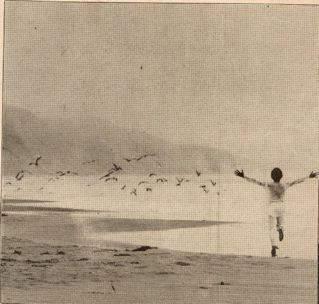{Disclosure: I was born and raised in San Francisco’s “Sunset District”–a misnomer, if there ever was one–so my intimacy with Fog has been long established.}
Most people, whether they admit it or not, harbor deep prejudices against Fog.
Those who don’t live on the Coastside, for instance, will usually choose a sunny day for a trip to Half Moon Bay. They merely check to see if the blanket of Fog is looming over the mountains which form the barrier between the Coastside and the Peninsula.
Since Fog is considered undesireable by most people, few opt to actually live with Fog. It really does take a certain type of individual who can adapt psychologically to foggy weather–which sometimes endures for days on end.
But maybe Fog has been underrated for too long. After all, Fog does have some positive attributes–for example, as a gauzy mood changer and an enhancer of mystery.
Fog has played a major role in the history of the Coastside. In the 1970s a major land developer kicked off a campaign to attract new people to the Coastside. His goal was to dispell the myth about the number of foggy days in Half Moon Bay. One of his gimmicks included an impressive calendar showing all the sunny days during the year. His promotion failed.
J.F. Wienke, an early settler, who bought the town of Moss Beach in the 1880s, was a forerunner in attempting to change public opinion about Fog. Wienke strongly believed that Fog possessed health-giving qualities and he built a seaside resort overlooking the Fitzgerald Marine Reserve. For a time he attracted prominent guests such as Stanford University President David Starr Jordan–but the resort mysteriously burned about 1912.
In the early 1900s, when the Ocean Shore Railroad planned to turn the Coastside into a Coney Island West, the intrepid developers must have come up with their brilliant concept on a bright sunny day. Surely un-resolveable engineering problems put the enterprise into the cold hands of bankruptcy but there may have been a lesser known cause: Fog.
A long streak of foggy weather probably accounted for the sharp drop in Ocean Shore passengers headed for Half Moon Bay. Coney Island West did not materialize.
Shortly after the Ocean Shore Railroad vanished from the landscape, Prohibition rolled in, and Fog suddenly proved to be a valuable asset. Rumrunners unloaded their illegal booze under cover of darkness on the isolated beaches enshrouded by the Fog that blurred their activities and provided safety. Needless to say, they made illicit millions.
To this day, Fog continues to be a key element that may determine the success or failure on the Coastside.

